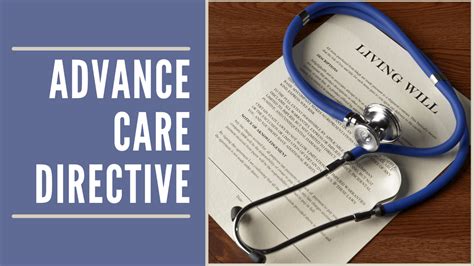Intro
Discover 5 essential medical directive tips for advance care planning, including living wills, healthcare proxies, and end-of-life care, to ensure your wishes are respected and your loved ones are prepared for medical emergencies and critical decisions.
Medical directives are essential documents that outline a person's wishes for their medical treatment in the event they become unable to communicate their decisions. Having a well-thought-out medical directive can provide peace of mind for both the individual and their loved ones. It ensures that their autonomy and preferences are respected, even when they cannot express themselves. In this article, we will delve into the importance of medical directives, their components, and provide valuable tips for creating an effective one.
The significance of medical directives cannot be overstated. They serve as a guide for healthcare providers, ensuring that the care provided aligns with the patient's values and wishes. This is particularly crucial in situations where the patient is facing a terminal illness, is in a coma, or has suffered severe injuries that render them unable to communicate. By having a medical directive in place, individuals can stipulate their preferences regarding life-sustaining treatments, pain management, and other critical care decisions.
Moreover, medical directives are not just for older adults or those with serious health conditions. Anyone, regardless of age or health status, can benefit from having one. It's an integral part of advance care planning, which involves thinking about, discussing, and documenting one's wishes for future medical care. This process encourages individuals to reflect on their values, beliefs, and goals, leading to a more personalized and respectful approach to healthcare.
Understanding Medical Directives

To create an effective medical directive, it's essential to understand its components and the process of developing one. A medical directive typically includes a living will and a durable power of attorney for healthcare. The living will outlines the individual's preferences for medical treatment, while the durable power of attorney for healthcare appoints a person to make medical decisions on their behalf if they become incapacitated. Understanding these elements and how they work together is vital for ensuring that one's wishes are respected.
Components of a Medical Directive
A medical directive is composed of several key elements, each serving a distinct purpose. These include: - **Living Will:** A document that specifies the types of medical treatment one wants or does not want if they become incapacitated. - **Durable Power of Attorney for Healthcare:** A document that names a person to make medical decisions on one's behalf if they are unable to do so. - **Advance Care Planning:** The process of thinking about, discussing, and documenting one's wishes for future medical care.Benefits of Having a Medical Directive

Having a medical directive offers numerous benefits, including:
- Peace of Mind: Knowing that one's wishes will be respected, even if they cannot communicate.
- Reduced Burden on Loved Ones: Family and friends are not left to guess what treatments one would want, reducing stress and conflict.
- Improved Quality of Care: Healthcare providers can focus on delivering care that aligns with the patient's preferences, potentially leading to better outcomes.
Creating a Medical Directive
Creating a medical directive involves several steps, including: 1. **Reflecting on One's Values and Beliefs:** Considering what is important and how these values should guide medical decisions. 2. **Discussing Wishes with Loved Ones:** Sharing one's preferences with family and friends to ensure they understand and can support one's decisions. 3. **Selecting a Healthcare Proxy:** Choosing a person to make medical decisions if one becomes incapacitated. 4. **Documenting Wishes:** Putting one's preferences into a formal document, such as a living will and durable power of attorney for healthcare.5 Medical Directive Tips

- Start Early: Don't wait until a medical crisis occurs. Begin thinking about and discussing your wishes with loved ones and healthcare providers as soon as possible.
- Be Specific: Clearly outline your preferences for different scenarios, including the use of life-sustaining treatments, such as ventilators and feeding tubes.
- Choose the Right Proxy: Select someone who understands your values and is willing and able to make decisions on your behalf. Discuss your wishes with this person to ensure they are aware of your preferences.
- Review and Update: Regularly review your medical directive and update it as necessary. Life changes, such as divorce or the death of a named proxy, may require revisions.
- Make It Accessible: Ensure that your healthcare providers and loved ones know about your medical directive and can access it when needed. Consider keeping a copy with your primary care physician and giving copies to your proxy and other relevant individuals.
Common Mistakes to Avoid
When creating a medical directive, there are several common mistakes to avoid, including: - **Not Discussing Wishes with Loved Ones:** Failing to communicate one's preferences can lead to misunderstandings and conflict. - **Not Keeping the Document Up-to-Date:** Failing to update the medical directive can mean that it does not reflect current wishes or circumstances. - **Not Making the Document Accessible:** Ensuring that the document can be found and accessed when needed is crucial for its effectiveness.Implementing a Medical Directive

Implementing a medical directive involves more than just creating the document. It requires ongoing communication with healthcare providers and loved ones, as well as regular review and updating of the document. By taking these steps, individuals can ensure that their medical directive is effective in guiding their care and respecting their autonomy.
Role of Healthcare Providers
Healthcare providers play a critical role in the implementation of medical directives. They must be aware of the document's existence and its contents to provide care that aligns with the patient's wishes. This involves: - **Respecting Patient Autonomy:** Recognizing and honoring the patient's right to make decisions about their care. - **Communicating with the Patient and Proxy:** Ensuring that the patient's wishes are understood and that the proxy is involved in decision-making as appropriate. - **Documenting Decisions:** Keeping a record of the decisions made and the care provided, including any deviations from the medical directive.Conclusion and Next Steps

In conclusion, medical directives are powerful tools that allow individuals to maintain control over their medical care, even when they cannot communicate. By understanding the components of a medical directive, following the tips for creation, and ensuring its implementation, individuals can safeguard their autonomy and ensure that their wishes are respected. The next steps involve continuing the conversation about advance care planning, encouraging others to create their own medical directives, and advocating for policies that support patient-centered care.
We invite you to share your thoughts and experiences with medical directives. Have you created one? How has it impacted your approach to healthcare? Share this article with someone who might benefit from understanding the importance and process of creating a medical directive. Together, we can promote a culture that values and respects individual autonomy in healthcare decisions.
What is a medical directive?
+A medical directive is a document that outlines a person's wishes for their medical treatment in the event they become unable to communicate their decisions.
Why is it important to have a medical directive?
+Having a medical directive ensures that one's autonomy and preferences are respected, even when they cannot express themselves, providing peace of mind for both the individual and their loved ones.
How do I create a medical directive?
+To create a medical directive, reflect on your values and beliefs, discuss your wishes with loved ones, select a healthcare proxy, and document your preferences in a living will and durable power of attorney for healthcare.
